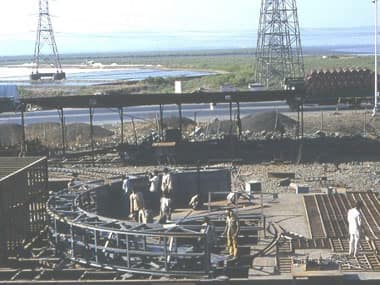Last Thursday (7 June), Maharashtra Chief Minister Prithviraj Chavan green-signaled preliminary work on a new city, this time Navi Thane across the Thane Creek, spread over 100 sq km. He asked three para-statal organisations to get into the act. That at once should cause joy if, and only if, it were to help bring a precipitous drop in real estate prices across the metropolitan region around Mumbai.
It is a given that new urban spaces have to come up to relieve the already saturated Mumbai region. It is also true that given astronomical prices, people working in the Mumbai metropolitan region are moving further and further away from their workplaces. The astronomical prices one is talking about concerns middle class homes in Mumbai, Thane or Navi Mumbai, not the Jindals paying Rs 36 crore for an apartment or Salman Khan seven times the market price.
[caption id=“attachment_337637” align=“alignleft” width=“380” caption=“Chavan’s plan for a new city across the Thane Creek is akin to Navi Mumbai that was conceptualised as a release valve for Mumbai.”]
 [/caption]
[/caption]
Chavan’s plan for a new city across the Thane Creek is akin to Navi Mumbai that was conceptualised as a release valve for Mumbai. The fear is that if it works the same way, it would turn out to be an exact replica of Navi Mumbai where high prices and rents rule and a person who seeks to escape Mumbai does not find relief.
Already cynicism has surfaced, with one comment on Facebook, instead of welcoming it, insisting that politicians might already have cornered land in the area and potentially stand to make killing over time. The fears are not entirely misplaced. But their wait, of course, would be as long as they take to drive the project.
Being two-thirds the area of Thane’s 147 sq km, it ought to make a difference, just as Navi Mumbai’s area being about equal to Mumbai’s was supposed to. But Navi Mumbai, as urbanologists say and planners concede, “took three times as long to populate than what was envisaged” - which translates to slow pace. That pace kept real estate prices up both in Mumbai and the evolving - it is not a done city yet - Navi Mumbai itself.
However, Thane’s civic chief, RA Rajeev, deserves some respect for the concept of developing Thane Creek as a marine drive and laying a road along it to let heavy traffic to bypass the city, especially the choking Ghodbunder Road. He talked about it in April, roped in a Belgian consultant and drew up a plan. The presentation to Chavan included these and the surprise was the Navi thane idea. He had kept it under wraps.
While the Chief Minister responded with uncharacteristic- and welcome - speed, the project itself would take a long time to mean anything for the Thane of now, which is running out of land, leading to shooting real estate prices. Thane is constrained by the creek on its east and the Sanjay Gandhi National Park to its west and north. Then there are pockets of private forests and there would be the same in Navi Thane too.
The same speed ought to be manifest in getting the details worked out, the coastal zone regulations tackled, the blueprint prepared and mass construction started. Mass does not mean only building for the poor; it could also be done for the better-off and the rich. But the point is to have the essentials in place - water, road, power. Unlike Navi Mumbai, which was built brick by slow brick, this ought to be a rapid-fire execution. More critical would be getting these done in coordination.
Of course no new city can be built overnight, though it can be dreamt of in one nap. But a whole lot of planning would be needed. For instance, Navi Mumbai was built but there were no roads or trains to link it with Mumbai. That came later. The early settlers walked in ankle-deep slush, shared cabs between Mankhurd and Vashi, groaned for clean water. Those are best avoided.
Already, Thane is devoid of a proper intra-city transport. For inter-city travel, it has to depend on miraculously working, but acutely overcrowded, trains and buses run by Mumbai’s BEST. An evolving Thane, which had a growth spurt which the civic body could not keep pace with, is a poorly run city in all respects. And if Navi Thane were to depend on the same stations which are thronged by half a million users everyday, it will be no solution.
In short, the idea is a good pudding. How it would be served would be its best test.
Mahesh Vijapurkar likes to take a worm’s eye-view of issues – that is, from the common man’s perspective. He was a journalist with The Indian Express and then The Hindu and now potters around with human development and urban issues.
)